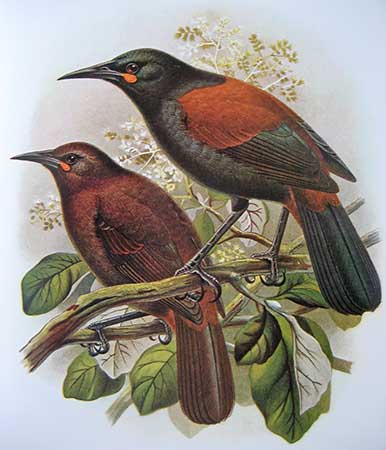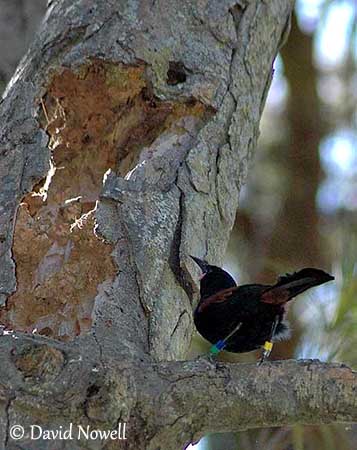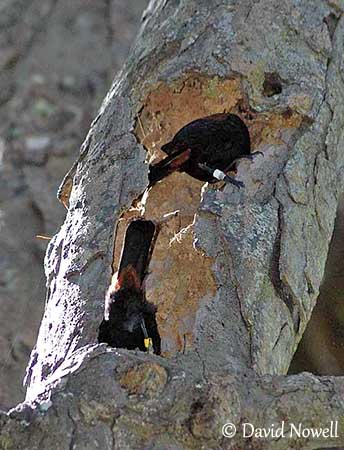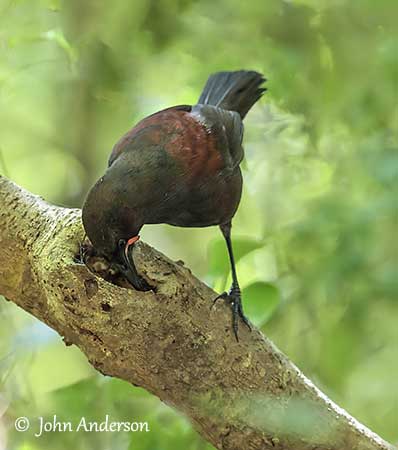
Fr: Créadion rounoir
Ang: South Island Saddleback
Maori: Tieke
All: Südinsel-Sattelvogel
Esp: Tieke de Isla Sur
Ita: Calleide caruncolato del Sud
Nd: Zuidelijke Zadelrug
Sd: Spetsnäbbad vårtkråka
Photographers:
John Anderson
John Anderson Photo Galleries
David Nowell
GALLERY
Illustration:
John Gerrard Keulemans (1842-1912)
(Illustration used by Walter Lawry Buller in « A History of the Birds of New Zealand” – 1888)
Text by Nicole Bouglouan
Sources:
HANDBOOK OF THE BIRDS OF THE WORLD Vol 14 by Josep del Hoyo-Andrew Elliot-David Christie - Lynx Edicions – ISBN: 9788496553507
KNOW YOUR NEW ZEALAND BIRDS by Lynnette Moon - New Holland Publishers – ISBN: 1869660897
BirdLife International (BirdLife International)
New Zealand bird status between 2008 and 2012
New Zealand birds and birding (Narena Olliver)
Wikipedia, the free encyclopaedia
Te Ara – The Encyclopedia of New Zealand
Page family Callaeidae
Page Passeriformes Order
South Island Saddleback
Philesturnus carunculatus
Passeriformes Order – Callaeidae Family
INTRODUCTION:
The South Island Saddleback is very similar to the North Island Saddleback, and is the most endangered of the two species. Decrease of populations caused by deforestation and introduced predators began in the mid-19th century. The species has restricted range, but has been successfully translocated on some adjacent islands where predator’s populations are managed.
DESCRIPTION OF THE BIRD:
Biometrics:
Length: 25 cm
Weight: M: 85 g – F: 75 g
The adult has glossy black plumage with faint blue sheen in sunlight. We can see the characteristic chestnut “saddle” on the back, contrasting with the dark body plumage. The chestnut colour extends to the rump and to secondary upperwing-coverts. The tail is black often with bluish sheen.
This species lacks the yellowish band on the upper edge of the saddle.
On the black head, there are fleshy, reddish-orange wattles at bill base, which increase in size and colour during the breeding season.
The strong, pointed bill is black. The eyes are dark brown. Legs and feet are black.
The female has similar plumage, but she is slightly smaller and has smaller wattles than male.
Unlike in the North Island Saddleback, the juvenile is different from adults. It has dark brown plumage overall, with chestnut wash on head and rump. Lores are blackish. It has small, pink wattles and yellowish gape.
The immature shows larger amounts of black on body and the wattles become slowly reddish-orange and increase in size.

John Gerrard Keulemans (1842-1912)
Adult (above)
Juvenile (below)
RANGE:
The South Island Saddleback is found in New Zealand and is present on several offshore islands in extreme NE and SW South Island, and islands off Stewart Island.
Several translocations on adjacent islands have increased the populations.
HABITAT:
The South Island Saddleback is restricted to forested range such as evergreen coastal forests, mixed lowland broadleaf forests and second growths.
On Ulva and Breaksea Islands, this species breeds in coastal scrub.
CALLS AND SONGS: SOUNDS BY XENO-CANTO
The South Island Saddleback is less noisy than the North Island Saddleback. It utters all year round a loud, repetitive chattering which can be heard through the dense forest. Both sexes sing, often throughout the day, although the territorial calls are mainly heard in the early morning. Melodious calls by males are used during mating and in territorial disputes.
Contact calls are quiet, and the bird also utters whistles.
BEHAVIOUR IN THE WILD:
The South Island Saddleback feeds mainly on insects and other invertebrates, spiders, berries and fruits, and takes nectar from flax flowers.
It is often accompanied by the New Zealand Fantail which enjoys the disturbed insects. The saddleback forages on the ground where it scratches through the leaf-litter. It moves gradually to the upper canopy among the tree branches. It uses its chisel-shaped bill to remove the loose bark, in order to locate hidden insects. It also digs into the rotting wood and searches for preys in dead leaves, bark crevices or loose bark.
It favours large insects such as weta (orthoptera). The prey is often held in one foot (like the Psittacidae) while it pulls the insect apart with the bill.

The South Island Saddleback breeds in spring and early summer. The typical “Archangel-Display” is performed by the male, and is associated with the drawing of the female into a nest-site chosen by the male.
Songs and vocalizations accompany the displays, like also courtship-feeding performed all year round, but much more during the breeding season to strengthen the pair-bonds.
They are cavity-nesters, solitary nesters and monogamous. They usually nest in tree hollows or epiphytes, and occasionally on the ground. The birds are seen in pairs and defend the territory all year round.
The South Island Saddleback can become very territorial and aggressive, performing a “battle-dance” with head-bobbing and fanned tail, accompanied by loud songs. At this moment, the wattles become bigger and brighter.
The species is sedentary and territorial throughout the year. The juveniles often disperse up to 3 kilometres from the parental territory.
They are weak fliers and are unable to sustain height. However, they are very active and move easily across branches.
REPRODUCTION OF THIS SPECIES:
The breeding season occurs in spring and early summer, but if the food resources are abundant, they can breed in early autumn too.
The South Island Saddleback nests in cavities such as tree holes or rock crevices. The nest is a shallow cup built by the female. It is made with twigs, pieces of bark, stalks and leaves. The inner cup is lined with fine grasses. It is placed in understorey or subcanopy.

The female lays 2-3 eggs and incubates during about three weeks. The chicks are brooded by the female, but both parents feed them. The juveniles fledge 25-27 days after hatching and still depend on parents for food. They remain in family group for several months.
Nest failures are due to natural avian predators if the site is free of introduced mammal predators.
PROTECTION / THREATS / STATUS:
The South Island Saddleback lives mainly on predator-free islands and mainland islands. Thanks to the intensive management of the populations and predator control, the numbers are slowly increasing and are currently estimated at 1200 individuals.
However, due to the restricted range, the species is still considered Near Threatened.
